Standalone or Non-Standalone, That Is Not the Question

It is broadly recognized that the Asia/Pacific region is leading the race to 5G. Operators in South Korea, Japan and China will be among the first ones in the world to launch commercial 5G networks of significant scale. For example, China is likely to have a pre-commercial grade 5G (soft) launch soon and 2020 is set to be the year for commercial roll out of the next generation mobile services. By then, it is expected that technologies and ecosystems will be fully ready and it will be the right timing for the full-fledged standalone (SA) mode of 5G.
As a decades-long cooperation partner with each and every operator, ZTE can understand their decision and support it. The Chinese operators all aim to be the best in their network quality and the service they can offer, in which case SA mode has its advantages.
To start with, by definition, SA mode means 5G radio built with 5G core networks, therefore it can realise all the new use cases the technologies have promised. Broadly speaking these include two types of cases. The first group is the cases that need vertical 5G environment, for instance network slicing for dedicated domains or locations or customers. The second group is typically in the ultra reliable low latency communications (uRLLC) category—for instance, autonomous driving cars, or advanced industrial manufacturing. In both cases we need end-to-end 5G connectivity.
When it comes to consumer access to 5G experience, although a few smartphone vendors have promised to introduce 5G-compliant handsets in the first half of 2019, the leading vendors (Samsung, Apple, etc.) are expected to bring their 5G flagship products to market in the Q3-Q4 2019 timeframe or even later, which means they are more likely to be available to the mass market towards the end of 2019 or sometime in 2020. This makes 2020 a reasonable target to launch 5G for the consumer markets.
Operationally, mobile operators may also find SA mode more straightforward to implement as the architecture is more simplified. Also, SA mode is the ultimate target network of 5G. Operators that implement SA mode will not have to go through, after a few years of 5G operation, another round of upgrade from non-standalone (NSA) to SA, which can be very costly, from the perspectives of investment, resources, timeline and operational efficiency. Meanwhile, operators could also find it a good opportunity to extricate themselves from the lock-in of 4G suppliers and to bring new vendors for 5G. This will be more than a good chance for the operators to optimize their Capex structure.
Thanks to the strong virtualization capabilities afforded by 5G architecture, it also makes business sense to bring on board new vendors to selected domains for their strength in these verticals.
Despite the recent momentum of SA mode from Chinese and global operators, there are also quite a number of operators with preference for NSA mode. For some operators this decision is based on speed advantage, the ability to roll out 5G as soon as possible. For others this option is also heavily related to cost, as by definition, NSA mode is 5G radio with LTE core networks, therefore saving the cost of building out the 5G core network, at least at the initial stage.
Some 5G use cases do not need end-to-end 5G coverage, and NSA mode will already be able to deliver good enough experience: For example, enhanced mobile broadband (eMBB) access like the service rolled out by Verizon Wireless; or most consumer IoT connections on cellular, which would need massive capacity but only generate small volumes of data traffic. Most OTT services are already operating on 4G, therefore what 5G can offer is an enhancement. For example, HD video streaming will be able to deliver on 4K or 8K, or virtual reality experience will become more life-like and more immersive. If these are their main target market segments, operators do not need to wait for all and ecosystem components to be ready before they roll out 5G services.
To speak as a long-standing cooperation partner with many of the world's leading operators, ZTE can understand their preference for NSA mode and support it. As a matter of fact, one of ZTE's most successful operator partnerships, the one with Hutchison Drei in Austria, has been built on the evaluation of Pre5G technologies. ZTE also believes that most operators starting with NSA mode will migrate to SA mode when the 5G technology and ecosystem are more mature and more cost efficient.
Backed by its strong track record of R&D leadership (over 1,000 essential 5G patents are only the tip of the iceberg) and commercial successes (decades of experience working with telecom operators all over the world), ZTE is happy and able to support whichever route to 5G its operator partners may choose, SA or NSA. It is encouraging to see that 5G is gathering momentum in many countries, especially in Europe. Spectrum auctions have been completed in Italy, the UK, and Finland, while auctions in Austria and Germany are going to be held early 2019. Meanwhile, ZTE also noticed that in some cases the prices paid out by operators to acquire 5G spectrums are so high that their reserves are almost dried. This may be worth bringing to the attention of the regulators and governments. Although the attempt to maximize return for a precious public asset (the electromagnetic spectrum) should not be faulted, draining operators’ funds may not be the most sustainable result for the industry in the long run.
[Keywords] Standalone(SA), Non-Standalone (NSA), 5G architecture